
July 9, 2006
[4 articles]
Big Blue focus: Controlling pollution
Air emissions decline, water wastes up
by Dan Shapley
Poughkeepsie Journal

[4 articles]
Big Blue focus: Controlling pollution
Air emissions decline, water wastes up
by Dan Shapley
Poughkeepsie Journal
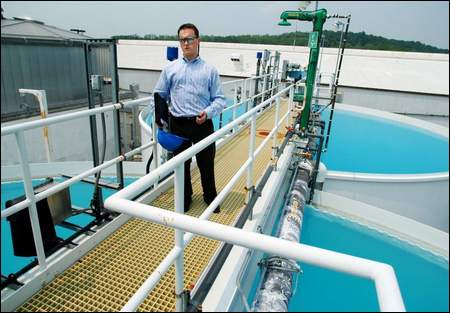
WICCOPEE — Few of the 4 million people expected to buy the Sony PlayStation 3, when it debuts this fall, will give a thought to the wastes poured into the tiny Gildersleeve Brook as IBM Corp.'s East Fishkill plant makes the high-powered chips buried in the game consoles' innards.
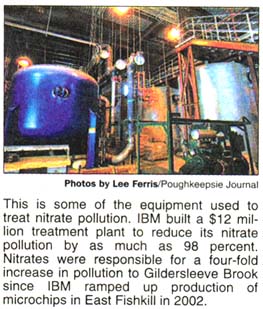
IBM's 70-member Environmental Group in East Fishkill thinks about it every day.
It has overseen an 86 percent reduction in air pollution in 10 years.
According to the latest federal data, Big Blue's East Fishkill plant was, pound for pound, the top polluter of water in New York in 2004. Water pollution increased four-fold since 2002, when IBM began production of its innovative chips on 300-millimeter diameter silicon wafers.
When the company's expansion is complete later this year and manufacturing capacity takes another giant leap forward, its use of polluting chemicals will increase again.
But IBM pollution flowing into the Gildersleeve Brook will decrease dramatically by the end of this year, when two new treatment plants are operational, IBM officials said during a recent site tour. The company has spent millions of dollars to curb air and water pollution at its plant — even sometimes in the absence of government mandates or the promise of a return on its investment.
The initiative is part of the IBM's global environmental strategy to reduce pollution — and to avoid the liability of expensive cleanups like those it now faces, which could cost the company up to $240 million.
200 chemicals used in process of manufacturing
by Dan Shapley
Poughkeepsie Journal
WICCOPEE — IBM Corp. calls its East Fishkill microchip fabrication plant "The World's Most Advanced Fab" — and industry group citations and the National Medal of Technology back up the boast.
If video game addicts know of it, it's for a different reason. Without it, millions of XBox 360 and Sony PlayStation 3 systems would be impossible.
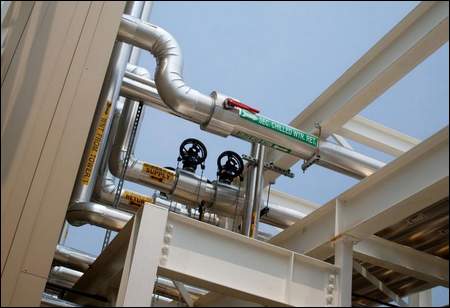
Building 323 is the oddly silent, dust-free heart of the company's most profitable business.
IBM's first-quarter profits of $1.7 billion jumped 21.4 percent from a year earlier. Those profits were hard-wired into sales of the gaming chips it manufactures at B323, as workers at the East Fishkill complex call the factory.
As it ramped up production of those chips in 2002, B323 also became the source of IBM's four-fold increase in water pollution.
The semiconductor industry is sometimes referred to as a "clean industry" — and making chips requires an intense attention to cleanliness, down to the dusting of visitors' shoes when they enter the building.
But producing chips takes a slew of hazardous chemicals. Local IBM engineers have focused on reducing the impact of those chemicals.
While IBM has phased out some of the most toxic, the facility still handles, uses, treats and disposes of chemicals at a scale that dwarfs other local industries.
In the "clean room," where chips are made, is a maze of machines — each white and bigger than a refrigerator. Each is called a "tool" so the entire factory, in some sense, is thought of as a single machine.
Tools process 300-millimeter diameter silicon wafers through 600 steps before spitting out finished chips. B323 uses about 200 chemicals — in gaseous, plasma and liquid forms — and 20 slurries, some of them proprietary and others in formulations being tested for the first time.
The result is a detailed network of chip circuitry measured in nanometers — about 1/400th of the diameter of a hair.
"These tools take very specialized chemicals to do that," said Mike MacDonald, the superintendent of the 300-millimeter site. "It lays out an electrical map."
These powerful chips bring life-like action to video games in homes across the country. The pollution produced to make them has its impact here in East Fishkill.
When IBM rebuilt B323 and its annex, engineers designed a tightly monitored spider web of drains and vents that channel each chemical into the clean room for use, and away from it when it's spent.
The floor of the clean room hides a four-foot tall alleyway of double-walled drain pipes. The pipes segregate chemicals and water into different streams, and channel them toward eight different treatment plants. A similar network on the ceiling channels gases to three treatment systems. Each waste can be treated in the most effective way.
"The key is segregation," said Jim Sales, a senior engineer with IBM's East Fishkill Environmental Group.
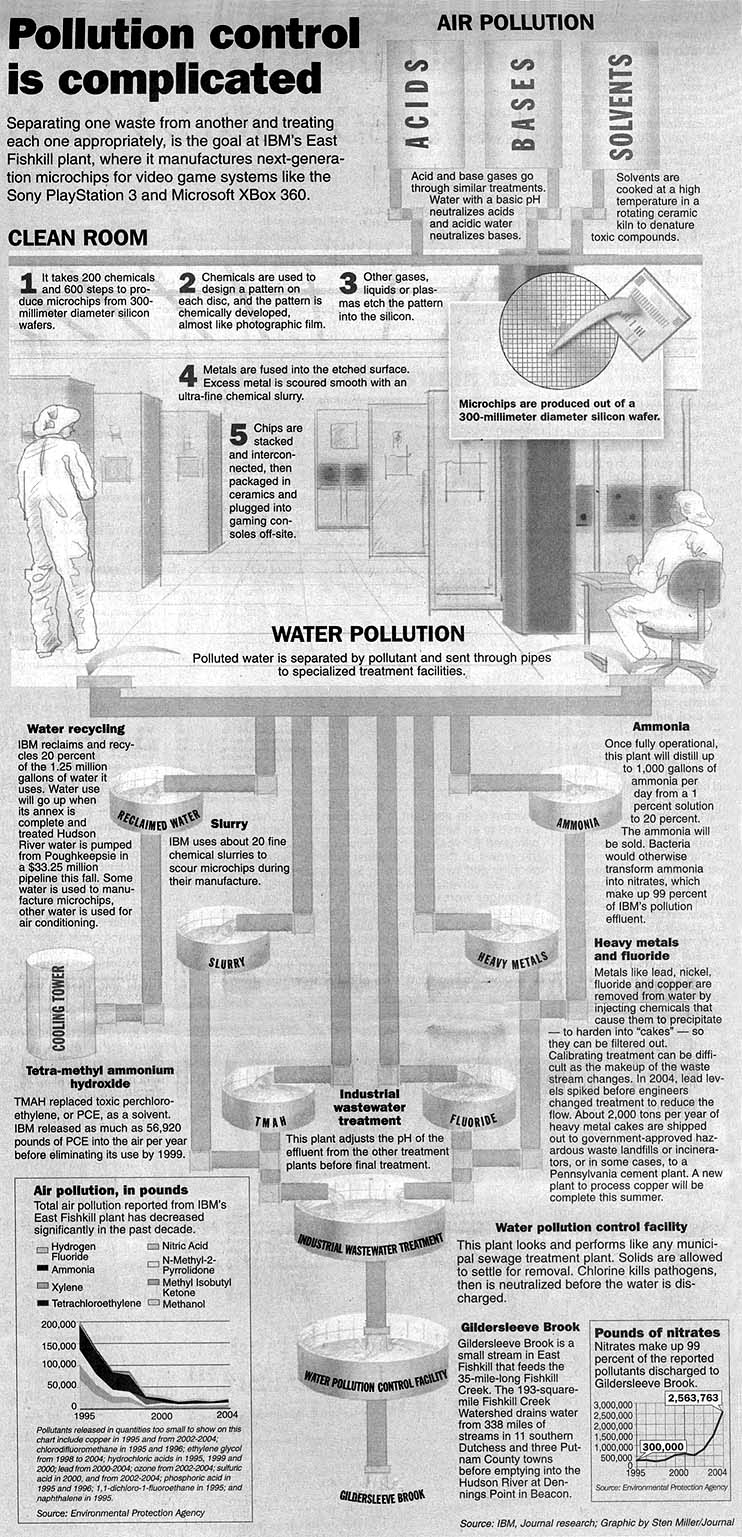
by Dan Shapley
Poughkeepsie Journal
As IBM ramped up production of the microchips that power video game systems, water pollution from its East Fishkill plant increased sharply, but its air pollution continued its decade-long downward trend.
In 2004, the IBM plant released 86 percent less toxic air pollutants than 10 years earlier.
Segregation and treatment of gases has helped curtail pollution, but the most dramatic reductions have come from changing the chemicals it uses to make chips.
The solvent perchloroethylene, also known as PCE or perc, was phased out in 1999, reducing hazardous emissions dramatically. In 1995, perc emissions from the East Fishkill stack topped out at 56,920 pounds.
PCE has been linked to cancer, birth defects, liver and kidney damage and other health problems. Improper disposal of the chemical also has landed IBM with responsibility for addressing contamination at numerous expensive Superfund sites, including the Shenandoah Road site in East Fishkill.
"There has been a big move from solvents to aqueous-based substances because of the environment," said Jim Sales, a senior engineer with IBM's East Fishkill Environmental Group.
Emissions of perfluorocarbons, or PFCs, which are widely used in the industry to etch chips and clean tools, have been reduced 90 percent in East Fishkill since 1998. PFCs, a type of greenhouse gas, stay in the atmosphere for decades and trap heat near the Earth's surface, causing global warming.
IBM, headquartered in Armonk, was cited by the Environmental Protection Agency this spring for its voluntary program to reduce emissions linked to global warming — by improving energy efficiency and reducing the use of PFCs. IBM is the only company to win the EPA's Climate Protection Award twice.
"PFCs are extremely stable. They're persistent in the environment, so the idea is we want to keep them out of the environment," said Bruce Tripp, the IBM engineer responsible for air pollution control and minimization.
Focus on water emissions
While air pollution has decreased, IBM polluted the Gildersleeve Brook with four times as much pollution in 2004 as in 2002.
The flow of copper, lead and nitrates into the tiny brook that feeds the Fishkill Creek have all increased sharply since IBM's production of next-generation video game chips was ramped up at Building 323, with nitrates accounting for 99 percent of the flow.
If ingested, lead can cause neurological damage and loss of intelligence. It is used for manufacturing the ceramic casings that hold microchips.
Copper, a less potent heavy metal, is used in chip circuitry, and its low resistance allows for powerful, energy-efficient computing.
Nitrates result from treatment of the ammonia in tetra-methyl ammonium hydroxide, which replaced PCE.
The federal and state governments require the treatment of ammonia, but not nitrates. Both are forms of the essential nutrient, nitrogen, found in nature.
In high amounts, nitrates can overload water with nutrients, causing excess algae and plant growth that consumes so much oxygen other aquatic life can't survive. If nitrates infiltrate wells, they may cause a dangerous drop in oxygen in a baby's blood — a condition known as "blue baby syndrome."
There are no legal limits on the amount of nitrates a facility can discharge, and the impact of nitrates on stream quality is not taken into account when granting pollution discharge permits.
When the Fishkill Creek Watershed Committee compiled scientific data about the creek, it found no information about the state of the creek. Crayfish, which are used to assess how toxic heavy metals, such as lead, accumulate in wildlife, have never been tested. Nutrient levels have not been measured.
Members of the IBM Environmental Group say nitrates don't harm the stream.
"This is probably no worse than a horse farm or cow farm," said Robert Newhard, manager of chemical and environmental programs. "There's definitely no effect as long as the stream is moving."
Treatment facility set up
But the rise in emissions troubled them enough to request $12 million to build a treatment plant that will remove up to 98 percent of nitrates from the waste stream by removing ammonia before it is converted to nitrates. The plant was completed this spring.
"We saw the increase. We said, 'We have to take some action to abate it,' " Newhard said. "Nobody required it. It was just the right thing to do."
IBM will sell the recovered ammonia to power plants so they can use it to reduce emissions of nitrogen oxides, which cause acid rain and smog. Despite that, IBM doesn't expect the new plant to pay for itself.
The company's investment in a $4 million plant to treat copper emissions, to be completed this summer, is driven by its obligation to comply with water pollution control laws.
IBM's copper discharge is near the limits set by the Department of Environmental Conservation, and the company exceeded its daily limit three times last year. It was not penalized because it has a strategy to reduce the pollution.
Its lead emissions also spiked in 2004 as chip production increased, but recalibrating the lead treatment plant it built in 2000 staunched that flow, officials said.
After treating all its waste products, including human waste and effluent from tenants such as Philips Semiconductors, IBM discharges 3.2 million gallons into the Gildersleeve Brook every day. It is permitted to discharge 6 million, said Bobbi Sablinski, the chief operator of the final treatment system, which resembles a municipal sewage plant.
"I've caught trout in that stream," Sablinski said. "I've seen muskrat, blue herons, ducks and geese."
On the Web
by Dan Shapley
Poughkeepsie Journal
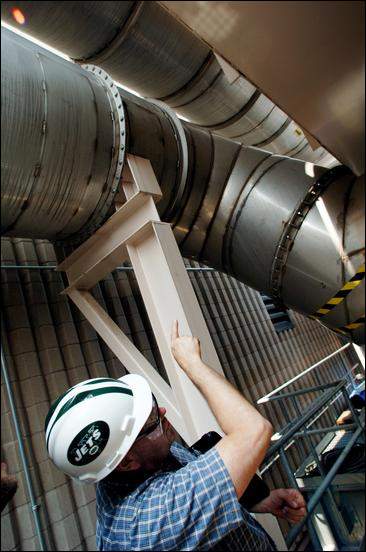
IBM could be liable for $240 million or more to help clean up more than 100 hazardous waste sites, including one in East Fishkill that may have increased some residents' risk of getting cancer.
Those liabilities, and an increasingly progressive environmental ethic, are driving the company's global strategy to prevent pollution.
IBM's Web site boasts of reducing toxic emissions by 86.3 percent worldwide since 1993 and reducing the use of polluting chemicals by hundreds of metric tons per year.
Now, IBM considers the cradle-to-grave environmental impact of its products. That means studying how the production of a chemical used in its plant might harm the environment or human health before it even reaches East Fishkill and thinking about how it can safely treat or dispose of it after use.
"We want to make sure whoever we're sending our waste to is handling it safely and reliably," Robert Newhard, manager of chemical and environmental programs, said.
Part of that is concern for the environment and human health, he said, but part of it is also economics: It often costs less to handle hazardous chemicals carefully than to pay to clean spills.
Liability may be $240 million
According to a recent filing with the Securities Exchange Commission, IBM is liable for an estimated $240 million in known expenses related to environmental issues. IBM has been identified as potentially responsible for at least 104 hazardous waste sites around the country, according to its Web site, though it believes it may be responsible for as few as 14.
Among them is the groundwater below its East Fishkill plant, and the Shenandoah Road federal Superfund site, an otherwise bucolic neighborhood set in the woods about three miles away. There, an IBM contractor, Jack Manne Inc., allegedly dumped the solvent perchloroethylene after using it to clean IBM microchip racks at a remote workshop on East Hook Cross Road in the late 1960s and early 1970s.
A government study found those who drank polluted water for many years may be more likely to develop cancer.
The government dismissed concerns from residents that daily doses of air pollution from the plant over the years increased their risk further, though re-searchers came to the opposite conclusion at a hazardous waste site IBM is addressing near its plant in Endicott, Broome County.
East Fishkill residents have complained of illnesses ranging from liver problems to skin rashes, though pinning the cause on industrial pollution is impossible.
IBM has paid for the installation of carbon water filters in more than 100 homes where wells are contaminated or susceptible to contamination. It has reimbursed some costs incurred by the Environmental Protection Agency since the pollution was discovered in 2000, including a proposed $750,000 payment being considered this summer. IBM also has committed to building a $10 million water system, scheduled to pipe clean water to about 150 homes in the area in late 2007.
In 2004, it also settled a civil suit threatened by 62 local residents, for an undisclosed sum.
'Dirty Dozen' award given
Contaminated sites related to IBM in New York inspired Shenandoah resident Denis Callinan to nominate IBM as one of the Citizen Environmental Coalition's "Dirty Dozen." The environmental group handed out 12 "awards" this spring to "draw attention to pollution and environmental health problems" in New York.
Callinan said he sees and smells less pollution from IBM's plant than he used to, but he does not trust the company. He believes some of the reduction in air pollution reflects the EPA's relaxed reporting requirements.
"The people in Wiccopee and the people in Shenandoah are trapped in the valley of these chemicals," he said.
More recently, a Poughkeepsie Journal report about the increase in pollution flowing into the Gildersleeve Brook from IBM's plant prompted concern among some local residents, water quality advocates and politicians.
Responding to the Journal story, U.S. Rep. Sue Kelly, R-Katonah, asked the EPA to investigate whether IBM's discharge was polluting wells at nearby homes. The EPA has agreed to visit East Fishkill in August, Kelly's office said.
East Fishkill Supervisor John Hickman also was concerned. But after conversations with IBM engineers, he is satisfied the company takes a proactive approach to preventing pollution now.
"I think they're a good corporate neighbor," he said. "I think they're trying to do the right thing."
On the Web
| Watershed Home | Media Menu |